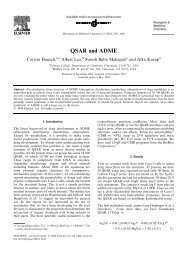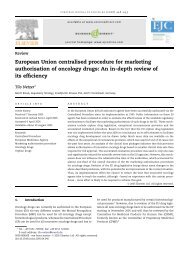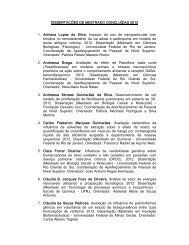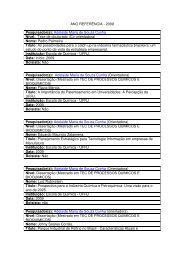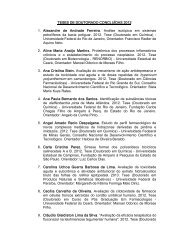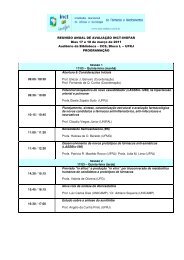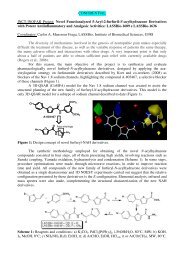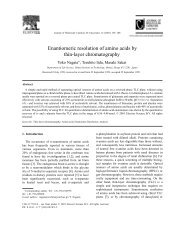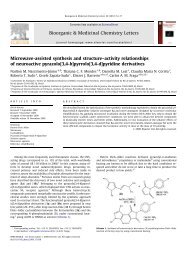View - ResearchGate
View - ResearchGate
View - ResearchGate
- No tags were found...
You also want an ePaper? Increase the reach of your titles
YUMPU automatically turns print PDFs into web optimized ePapers that Google loves.
4342 Journal of Medicinal Chemistry, 2004, Vol. 47, No. 18 Perspectivemia. 31 On the other hand, the corresponding activemetabolite, acetaminophen, is predominantly clearedvia phase II conjugation reactions (sulfation and glucuronidation)and has a greater margin of safety relativeto phenacetin. 32In general, drug metabolism reactions convert lipophiliccompounds to more hydrophilic, more watersolubleproducts. An improvement in the solubilityprofile is an added advantage, particularly in thecurrent drug discovery paradigm where many drugcandidates generated during lead optimization havepoor aqueous solubility.An active metabolite can serve as a modified leadcompound around which new structure-activity relationshipscan be investigated during the lead optimizationstage of drug discovery. For example, this approachwas used in the discovery of ezetimibe, a cholesterolabsorption inhibitor. 1,18,33 In these studies, a lead candidate(SCH48461) gave rise to a pharmacologicallyactive biliary metabolite upon oral administration torats that was approximately 30-fold more potent thanthe parent molecule. Further optimization of the metabolitethrough structural modification led to thediscovery of ezetimibe, a molecule that was approximately400-fold more potent than the initial leadcandidate.In summary, tracking active metabolites at the drugdiscovery stage not only is important to correctlyinterpret the pharmacological effects in preclinicalspecies but may also lead to the discovery of a leadcandidate with superior drug developability characteristics.Detection of Active Metabolites during DrugDiscoveryThe exploration of the potential for formation of activemetabolites can be carried out with varying degrees ofdirection from information gathered through metabolism,pharmacokinetics, and biological/pharmacologicalassays. An example of undirected screening of activemetabolites would be the modification of chemicallibraries by subjecting them to metabolizing systemsand subsequently using these modified libraries forhigh-throughput screens, either against the intendedtarget or more broadly. This example is a way togenerate increased molecular diversity from a givenchemical library. However, this approach requires significant“deconvolution” efforts when activity is foundin mixtures. To increase the success rate and decreasethe number of compounds screened to a manageablesize, the search for active metabolites could be limitedto those compounds or chemotypes showing high clearancerates in in vitro metabolic stability or in vivoexposure screens.On the other hand, activity assays may serve as amore rationale approach to the exploration of activemetabolites. This is most often and most effectively donein the setting of an in vivo efficacy experiment thatallows for both pharmacodynamic (PD) and pharmacokinetic(PK) information to be gathered. Analysis of therelationship between the PD endpoint and the PKprofile will sometimes demonstrate an apparent disconnectbetween the two data sets and point to thepossibility that an active metabolite is responsible forFigure 3. In vitro and in vivo plasma enzyme inhibition vsconcentration of BMS-A.some of the activity. These disconnects can serve asclear trigger points for the initiation of active metabolitesearches.For example, Van Heek and co-workers observed alead candidate that underwent extensive first-passmetabolism and yet elicited a significant level of pharmacologicalactivity. 33 To evaluate the biological activityof the in vivo biotransformation products, they collectedsamples of bile from rats dosed with a lead compoundand directly administered the bile samples to bile ductcannulated rats via an intraduodenal cannula. In acontrol study, the parent compound prepared in blankbile was dosed in a similar fashion to the recipient rats.Results from this study indicated that the in vivoactivity elicited by the bile samples was higher than theparent control sample, clearly indicating the presenceof an active metabolite(s) that was more potent thanthe parent compound. To identify the active component,the bile sample was then fractionated and each fractionwas tested for biological activity. The structure of themetabolite was then established following the detectionof the active fraction. As mentioned before, furthermodification of the active metabolite led to the discoveryof ezetimibe.Another example is the recent pharmacological evaluationof a BMS drug candidate (BMS-A), where higherin vivo potency was observed than was expected fromeither the PK data or from in vitro activity data. 34 Thestudy involved enzyme activity measurements in ratplasma in vitro and ex vivo. To measure the enzymeactivity in vitro, known concentrations of the drugcandidate were spiked to fresh plasma collected fromrats at concentrations that would give a reasonabledose-response curve. An appropriate concentration ofthe enzyme substrate was then added to each sample,and the enzyme activity was measured. The resultingdose-response curve is shown by the right-hand sidecurve in Figure 3. The in vitro data were then comparedwith the enzyme activity data obtained using ex vivoplasma collected from rats administered intravenouslywith an appropriate dose of the drug candidate. Theactual concentrations of the drug in the plasma sampleswere determined by LC/MS/MS (liquid chromatographyand tandem mass spectrometry). As shown in Figure3, the inhibitory activity appears to increase when thecompound was given in vivo compared to the in vitromeasurements at similar nominal concentrations of the



